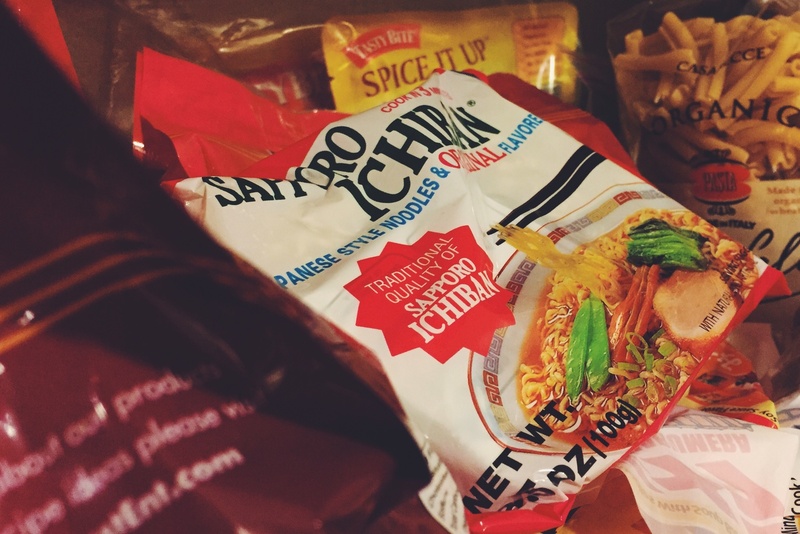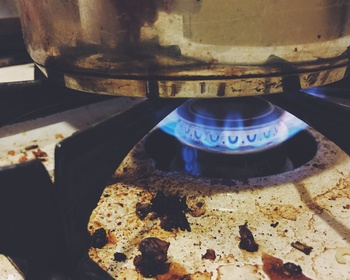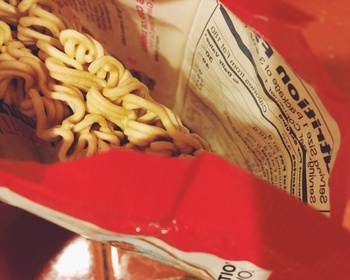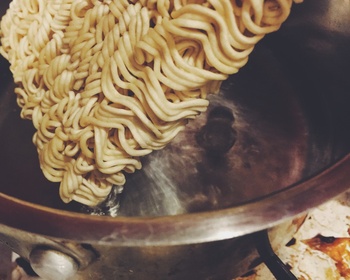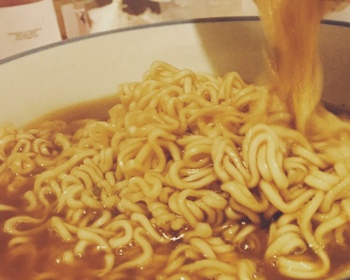I had this fantasy last week where I decided I would get full nights of sleep seven nights in a row.
This fantasy did not happen.
Tuesday night was the season launch night for an outdoor art series I produce, meaning that the weeks leading up to it were filled with mental lists and last minute phone calls. Ten days prior the weather report said that it was possibly going to rain. Two days prior the weather report said that it was definitely going to rain. The 48 hours leading to the show was a giant rush of last minute coordination, map-making, logistic revision, and budgeting for dry space that culminated in Monday night quiet as I lay in bed in the middle of the storm, unable to sleep due to the whirling cyclone of e-mails and Google docs that hovered directly above my head.
So I made ramen.
Invented in the ’50s by Taiwanese-Japanese inventor Ando Momofuku (who has a popular restaurant named after him in NYC), instant ramen has become a default quick meal around the world. In Japan, cup-men (カップ麺 or “cup noodles”) are a cultural staple. In Hong Kong, instant noodles are among the noodle types available in soup noodle restaurants. In Korea, the instant noodle block is a familiar element in dishes like budae jjigae.
To me, instant ramen is a Lego piece in the story of my life. Forget actual ramen—I didn’t have tonkotsu broth until I was in high school. Ramen, as I understood it growing up, came in a red packet and was best served on rainy days when my mom didn’t particularly feel like making something elaborate for lunch. Ramen took three minutes to make and two minutes to eat and left a trail of broth-marks throughout the line of library books that perched against my bowls through the years.
Ramen was brought to school sealed in the packet then broken out during recess and smashed to bits to be eaten out of the bag. Ramen was the lunch of choice on school days if I ended up at home as a kindergartener or at a friend’s house as a high school student. I had my first Shin Ramyun at a friend’s house senior year and learned that I don’t handle spicy things very well. Nothing humbles you like the inability to finish a bowl of noodles while your host drinks down the soup.
At some point my mom figured out that the sodium content was comparable to that of a salt mine and started to cut back on buying the ramen packets (we lived in Vancouver at the time and could get them in boxes of 24 at Costco), but she never really stopped. When I went off to college she begrudgingly sent me a handful with a stern phone call that I was to limit how many I ate.
I was limited only by my lack of access to a stove and I wasn’t about to microwave it like a neanderthal.
At 26 years old I still keep a 5-pack of Sapporo Ichiban original flavor in my cupboard. I can’t even call it comfort food—mabo tofu and curry throw me back to childhood, but instant ramen remains eternally contemporary. There is something timeless about a plain bowl of noodles and a good book.
So last Monday night, in the eye of the storm, I made my ramen, watched an episode of Mushi-shi on Hulu, then lay in bed until thoughts of Tuesday were replaced by sleep.
The show went fine. I found time to rest. We are a week later.
I’m out of ramen packets right now. A shopping trip is in the cards.
*This article was originally published on the author’s blog, DOWN LIKE JTOWN, on April 14, 2015.
© 2015 Sean Miura


